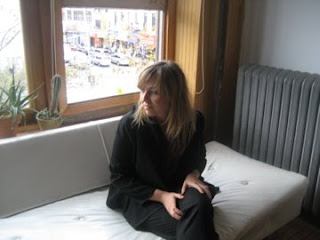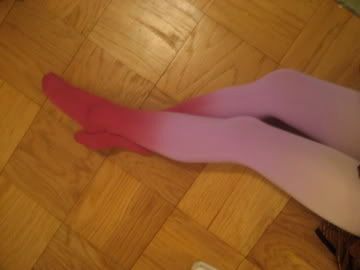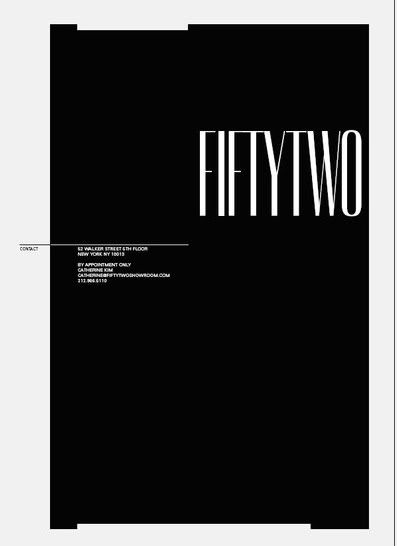
Munich born designer
Iris Loeffler showed her first collection for Spring at New York Fashion Week. The collection is largely based on movement, and quite poetically inspired by earthquakes, or the sensation of the land moving under your feet. Though I missed her show, Iris took the time to answer some questions and show me her collection in person, as she prepares to go into production. Look for her clothes at EVA this spring.
 Iris Loeffler, wearing her own designs.
Iris Loeffler, wearing her own designs.Tiffany: First off, Congratulations on your debut collection for SS09. Most young designer start out by taking appointments or doing a presentation, but you entered your first New York Fashion Week with a full runway show at the
LaViola Bank Gallery. What motivated you to take on such a daunting task?
Iris: Thank you. Doing this collection, to be honest, kind of started as a small, and almost selfish project for me. I had been interning with all those amazing designers here in New York, I knew I wanted to stay in this city, but I wasn't quite sure what to do, and on the other hand, I had all those ideas, and this urge to create something that came out of my own head. There's so much creative energy going on this city, it felt like a relief to let my own out. Designing and producing this collection, while still interning with Maria Cornejo, just felt very natural. I did everything on my own, made all the show-samples myself; so I worked 24/7, but it felt great.
I took all those small steps, never having the feeling I was facing a big challenge. Quite the opposite: I realized more and more, that this is exactly what I want to do.
 One of a series of gold sequined tops. Photo by Pari Dukovic.
One of a series of gold sequined tops. Photo by Pari Dukovic. T: I heard that during your runway show, you had industrial fans placed along the catwalk, exaggerating the sense of dynamism that's built into your clothing. How important a factor is movement in the design of your clothing?
I: Initially the show was planned as a presentation, but we faced the problem of having a very calm and static atmosphere, while the clothes tend to have this floaty and light character. To show the actual volume of the garments, and create a more "dramatic" mood, the fans seemed to be a perfect element. Eventually, doing a real runway show, seemed more and more reasonable. What's significant about my work is my approach to constructing a garment: most of the patterns are geometric, so i do start minimal, with a rectangle or a square, and then the way the fabric drapes and falls creates the silhouette. Movement, therefore, is very important, to show the actual shape of the single garments.
T: Tell me about the woman that you design for. How much do you serve as your own muse?
I: First of all, I would never design anything I wouldn't wanna wear myself. And I think, that's why the pieces speak to many different kinds of women: it's not so much a question of age or profession. The pieces are minimal and timeless in a way, which on the one hand, leaves a lot of space for personality, and on the other hand makes them easy to wear, and easy to combine with your own look.
 One of Iris's amazing distressed leather jackets, with an unfinished edge. Each one she makes is unique.
One of Iris's amazing distressed leather jackets, with an unfinished edge. Each one she makes is unique.
T: Before you started your own collection, you had an impressive run of internships with VPL, Zero Maria Cornejo, and ThreeASFOUR. What was the most important thing that you learned from each of these designers along the way?
I: I feel very lucky that I fell into this perfect spot of smaller, "downtown-designers," who are all friends with each other, which i think is amazing, by the way. I had the chance to experience the way a small label works very closely. I got to look into all those different aspects, starting with resourcing, pattern-making and how to actually develop a collection; but also press work, putting a show together, sales... and also all the problems you deal with each and every day. It is a lot of work, and way less glamorous than it seems from the outside, but it didn't scare me away, I felt very ready and prepared; starting my own company is not that big of a step anymore. The three companies are all very different in what they do, so that definitely pushed my own creativity a lot further. It was a fantastic time, and I'm very thankful for what I got to learn, and who I got to meet, the most amazing people came into my life in those few months.

A floor length hooded cape with an unattached silk lining.
T: You moved to New York from Germany, and are in the process of getting a Visa to stay. How does American Fashion differ from what's going on in Germany right now? What made you decide to move and work in New York?
I: New York had always attracted me, but it wasn't my plan to actually really move here. After graduating from fashion school one year ago, I travelled here, met ThreeASFOUR through a friend, and decided to spend the winter in NY to intern with them - and then return to Europe where I had 2 job offers from major corporate Fashion Labels. I just couldn't imagine leaving New York anymore, and also: after experiencing how artistically people like ThreeASFOUR or Maria Cornejo work, a corporate company didn't attract me at all anymore. The fashion scene in Germany, well, it depends on how you want to work as a designer, I guess. But that's not what I would chose for myself. I like New York's pace and energy, it made me wanna do what i do now, who knows if I had taken a similar direction if I had gone back, probably not.
T: Where do you see yourself in five years?
I: That's really difficult to say. When i look back, how much my life has changed in the last 11 months, 5 years seems like a long, long time to plan ahead. I hope, I'll be able to do what i do now. Success is important in terms as it enables you to continue. Especially In this business, and in these times. So for now, I'm focussing on the next months, the next collection and show, doing the best I can to make it happen and to make the best out of everything that crosses my way. But I'm a very positive person, so far, following my instincts worked out well.
 The best D.I.Y. shoes ever. For the runway show, Iris bought cheap shoes at the mall, cut them apart, and then had a shoe cobbler build the leather pieces she designed back onto the base of the shoe.
The best D.I.Y. shoes ever. For the runway show, Iris bought cheap shoes at the mall, cut them apart, and then had a shoe cobbler build the leather pieces she designed back onto the base of the shoe. The final showpiece, this dress is made from Ultrasuede with a silk overlay and a multitude of hand painted wood blocks appliqued across the shoulders. The movement that is built into the piece is evocative of the undulation of land that takes place during an earthquake. This picture unfortunately doesn't do the dress justice.
The final showpiece, this dress is made from Ultrasuede with a silk overlay and a multitude of hand painted wood blocks appliqued across the shoulders. The movement that is built into the piece is evocative of the undulation of land that takes place during an earthquake. This picture unfortunately doesn't do the dress justice.
One last view of the floorlength hooded cape. Photo by Pari Dukovic.
-Tiffany
 Happy Halloween! I may be having trouble abstaining from consuming the entire bag of Heath Bars and Whoppers that I ostensibly bought for trick-or-treaters, but here is a Halloween treats I can share with you all: what is more Gothic than a human skeleton shrink wrapped in black leather? Jewelry designer Natalia Brilli, known for wrapping pearls, bones, and chains in leather to create her signature pieces, has created a traveling window installation of rock and roll skeletons performing on leather wrapped drum kits, guitars and microphones. The windows started in Parisian store Maria Luisa during Fashion Week, and will be coming to Barneys New York in December before heading to Art Basil. I can't wait! For more on Natalia Brilli, check out her haunting video here.
Happy Halloween! I may be having trouble abstaining from consuming the entire bag of Heath Bars and Whoppers that I ostensibly bought for trick-or-treaters, but here is a Halloween treats I can share with you all: what is more Gothic than a human skeleton shrink wrapped in black leather? Jewelry designer Natalia Brilli, known for wrapping pearls, bones, and chains in leather to create her signature pieces, has created a traveling window installation of rock and roll skeletons performing on leather wrapped drum kits, guitars and microphones. The windows started in Parisian store Maria Luisa during Fashion Week, and will be coming to Barneys New York in December before heading to Art Basil. I can't wait! For more on Natalia Brilli, check out her haunting video here. 



















































